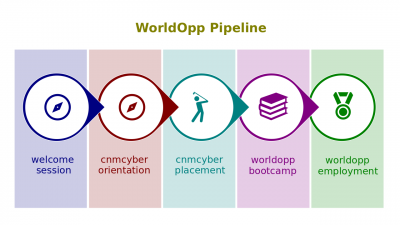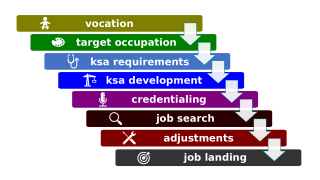Difference between revisions of "Career Waterfalls"
(→Script) |
(→Script) |
||
| Line 16: | Line 16: | ||
===Script=== | ===Script=== | ||
| − | : | + | :In [[career waterfall]]s, the development progress is seen as flowing steadily downwards through the phases. These phases may vary, but they are planned in advance. |
| − | |||
| − | |||
:One's ''waterfall'' may start with discovering one's [[vocation]]. Usually, a kid is asked "who do you want to be when you have grown up?" If the kid doesn't know, a college [[career counselor]] will ask "what do you like to do?" either in person or through some aptitude test. | :One's ''waterfall'' may start with discovering one's [[vocation]]. Usually, a kid is asked "who do you want to be when you have grown up?" If the kid doesn't know, a college [[career counselor]] will ask "what do you like to do?" either in person or through some aptitude test. | ||
| Line 24: | Line 22: | ||
:When one's vocation is identified, suggesting one's target [[industry]] and/or [[occupation]] may come next. If parents don't have their vision for their child, the ''counselor'' may introduce him or her to the [[Occupational Outlook Handbook]] or another resource, so the targets can be established. | :When one's vocation is identified, suggesting one's target [[industry]] and/or [[occupation]] may come next. If parents don't have their vision for their child, the ''counselor'' may introduce him or her to the [[Occupational Outlook Handbook]] or another resource, so the targets can be established. | ||
| − | + | :Identifying [[work-related competence]] that is needed for a particular [[rank position]] may be another phase. Colleges and universities usually recommend obtaining [[educational credential]]s first. | |
| − | + | ||
| + | :Development of one's [[KSA]]s may take years. For many, the most difficult part is to find an [[entry-level job]] after graduation from [[educational institution]]s. So, development one's [[employment credential]]s can take even longer. | ||
| + | |||
| + | :[[Job search]] and landing one's job in the target occupation and/or target industry would end that ''waterfall''. At this stage, the grown-up kid may discover his or her real ''vocation''. | ||
| + | |||
| + | :By their definition, ''career waterfalls'' are sequential. Agile is another approach to administration of [[career project]]s. [[Agile career project]]s assume frequent adjustments that reflect the newly-discovered information. | ||
| + | |||
'''[[Agile Career Projects]]''' is the successor [[lectio]]. | '''[[Agile Career Projects]]''' is the successor [[lectio]]. | ||
==Quiz== | ==Quiz== | ||
Revision as of 21:18, 14 May 2020
Career Waterfalls (hereinafter, the Lectio) is the second lesson part of the Career Endeavors lesson that introduces its participants to career projects and related topics.
This lesson belongs to the Introduction to Careers session of the CNM Cyber Orientation. The Orientation is the second stage of the WorldOpp Pipeline.
Contents
Content
The predecessor lectio is What Career Endeavor Is.
Key terms
- [[]].
- Career waterfall. A sequential process where progress is seen as flowing steadily downwards through the phases. These phases may vary, but often consist of (a) discovering one's vocation, (b) suggesting one's target industry and/or occupation, (c) identifying work-related competence needed for a particular position, (d) development of one's KSAs, (e) development one's employment credentials, (f) job search, (g) adjustments to the job market, and/or (h) landing one's job in the target occupation and/or target industry.
Script
- In career waterfalls, the development progress is seen as flowing steadily downwards through the phases. These phases may vary, but they are planned in advance.
- One's waterfall may start with discovering one's vocation. Usually, a kid is asked "who do you want to be when you have grown up?" If the kid doesn't know, a college career counselor will ask "what do you like to do?" either in person or through some aptitude test.
- When one's vocation is identified, suggesting one's target industry and/or occupation may come next. If parents don't have their vision for their child, the counselor may introduce him or her to the Occupational Outlook Handbook or another resource, so the targets can be established.
- Identifying work-related competence that is needed for a particular rank position may be another phase. Colleges and universities usually recommend obtaining educational credentials first.
- Development of one's KSAs may take years. For many, the most difficult part is to find an entry-level job after graduation from educational institutions. So, development one's employment credentials can take even longer.
- Job search and landing one's job in the target occupation and/or target industry would end that waterfall. At this stage, the grown-up kid may discover his or her real vocation.
- By their definition, career waterfalls are sequential. Agile is another approach to administration of career projects. Agile career projects assume frequent adjustments that reflect the newly-discovered information.
Agile Career Projects is the successor lectio.

